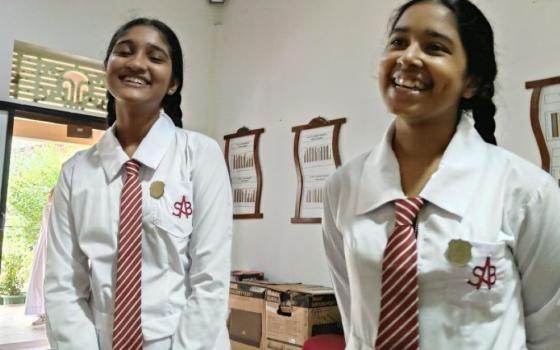Religious Life
THE SUBVERSIVE POWER OF LOVE: THE VISION OF HENRIETTE DELILLE
By M. Shawn Copeland
Published by Paulist Press, $9.95
The Subversive Power of Love is a slim volume, but it provides memorable insight into the institution of slavery in the United States, and in New Orleans in particular, and paints a picture of the spiritual courage of a black woman whose choice to found a religious order defied the inhumane beliefs that undergirded that institution.
 Based on M. Shawn Copeland’s 2007 Madeleva Lecture in Spirituality, The Subversive Power of Love celebrates the “moral audacity and spiritual courage” of Henriette DeLille, founder of the Sisters of the Holy Family. DeLille, born in 1812, came from a line of femmes de couleur libres (“free women of color”) who lived under Louisiana’s system of plaçage, in which black women entered into “a more-or-less permanent sexual arrangement” with white men and bore them children. DeLille would have been expected to follow in this path but she chose a different way.
Based on M. Shawn Copeland’s 2007 Madeleva Lecture in Spirituality, The Subversive Power of Love celebrates the “moral audacity and spiritual courage” of Henriette DeLille, founder of the Sisters of the Holy Family. DeLille, born in 1812, came from a line of femmes de couleur libres (“free women of color”) who lived under Louisiana’s system of plaçage, in which black women entered into “a more-or-less permanent sexual arrangement” with white men and bore them children. DeLille would have been expected to follow in this path but she chose a different way.
“In founding a religious congregation, Henriette DeLille asserted black women as fully capable of chastity, as chaste -- as fully capable of possessing, choosing and disposing of themselves and their own bodies,” Copeland writes. Her vision “not only contravened slavery’s vicious stereotypes of black women as impious, promiscuous and lewd, but constructed an alternative” to the plaçage system.
While Copeland does offer the disclaimer that we cannot know fully what motivated DeLille, she makes a powerful case for the spiritually subversive nature of DeLille’s actions. And DeLille’s own words unveils what was underlying: “I believe in God. I hope in God. I love. I wish to live and die for God.”
Nicholas Buxton came into the monastic limelight as a participant in the BBC 2005 reality show “The Monastery.” But unlike some of his fellows on that show, in which five men stayed with Catholic Benedictines for 40 days, Buxton came to it with longtime interest and experience with monastic life, albeit many years of that spent in Asia, at Buddhist monasteries. Upon his return to England, he wished to rediscover the Christian faith he had abandoned in his youth.
 TANTALUS AND THE PELICAN: EXPLORING MONASTIC SPIRITUALITY TODAY
TANTALUS AND THE PELICAN: EXPLORING MONASTIC SPIRITUALITY TODAY
By Nicholas Buxton
Published by Continuum, $19.95
Now an Anglican priest, Buxton, in Tantalus and the Pelican, outlines his experiences in the East and touches on the reality show experience. But he is more interested in exploring the draw of monasticism and how its spirituality is one very much needed today, in a culture where “we have lost our sense of accountability before God, before nature, and before each other.” This broader focus, and his engaging writing, save the book from being just another navel-gazing memoir of a spiritual search.
All the same, his reflections on participating in “The Monastery” are stand-outs. He likens the urge to “perform” as a camera is turned on oneself as only an exaggeration of the mask of self that monastic spirituality seeks to uncover. As for the series itself, while it received praise and was not exploitive or sensationalized, Buxton writes, “By presenting religion as ‘spirituality’ -- with all the attendant connotations of association without commitment -- the program subtly undermined its own subject matter. ... It did not challenge our consensual norms of individualism and consumerism, so much as confirm them.”
 A TASTE OF HEAVEN: A GUIDE TO FOOD AND DRINK MADE BY MONKS AND NUNS
A TASTE OF HEAVEN: A GUIDE TO FOOD AND DRINK MADE BY MONKS AND NUNS
By Madeline Scherb
Published by Tarcher/Penguin, $15.95
A Taste of Heaven suffers from a bit of an identity crisis: It’s a buying guide, a travel guide covering two continents, and a cookbook, sprinkled with capsule histories of monasteries and convents and with reflections on religious life.
Mostly, it’s about food, created by monks and nuns in the United States and several European countries, and the descriptions of the care that goes into their production are interesting. The way the book is organized -- by type of food and drink sold -- makes it most useful in its buying guide persona. (The author supplies contact information, Web sites and guidance on international ordering.) But this organization can throw the book’s two other personas -- travel guide and cookbook -- into disarray, with destinations jumping around from country to country, and recipes from desserts to main dishes to drinks and back again.
Still, it’s not completely unworkable. If you’re going to, say, Belgium, you can bookmark the destinations there. Or you can buy Trappist ale and prepare several courses’ worth of dishes from that section.
Author Madeline Scherb visited many of these communities, and the portraits she paints of them are appealing at first, but her idealized take and twee descriptions get a little wearing. That includes the repeated appeals for vocations along the lines of “The nuns are friendly, the Mother Abbess is kind. This is the closest one will ever get to living in a castle, and there is plenty of chocolate to eat” -- cute for such a book, but NCR readers might find it superficial. But, again, it’s a book to buy for the food, not for guidance in praying for vocations.
Teresa Malcolm is an NCR staff writer. Her e-mail address is tmalcolm@ncronline.org.



